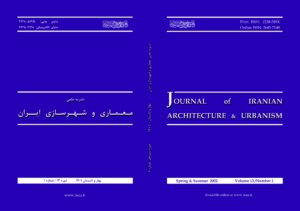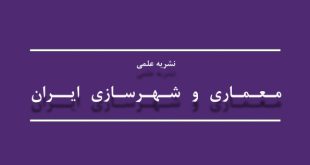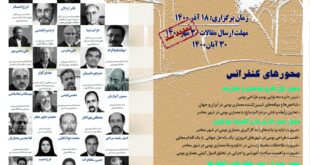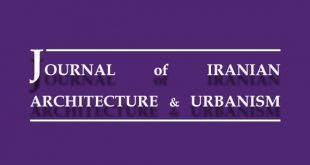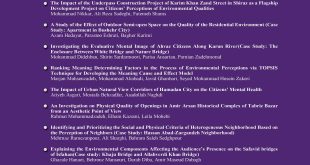Journal of Iranian Architecture and Urbanism , No. 1, Volume 13, Spring & Summer 2022, was published.
What you read in this issue:
Application of Linkography method to analyze the teacher-student interactions in the basic architectural design studio
Shima Mehrad; Omid Dezhdar; Gholamreza Talischi
Optimization of spatial organization in architectural plan design using particle swarm optimization algorithm
Maryam Sadeghian; Akram Hosseini
Suggesting a method for preparing the color palette of the place, an approach to conserve the historic urban landscape (Case study: Jolfa neighborhood in Isfahan)
Bahareh Tadayon; Mahmoud Ghalehnoee; Reza Abouei
Identification of facade semantic components of residential buildings from the perspective of the citizens (Case study: Ardabil city)
Masumeh Alamrasi; Ghasem Motalebi; Manouchehr Foroutan; Sara Jalalian
Identifying and prioritizing the affecting factors on enhancing the mediating quality of architecture (Case study: Faculty of Architecture and Urbanism, Tabriz Islamic Art University)
Ali Pourahmad Ghalejough; Farzin Haghparast; Mohammad Taghi Pirbabaei
The judgment strategies of architectural designs and its role in the students’ learning process
Maedeh Mayahi; Saeid Mirriahi; Mohammadebrahim Mazhary; Yadollah Mehralizadeh
A framework for regeneration of historical contexts with culture-led approach to achieve sustainable tourism development (Case study: Urmia historical context)
Kyoumars Habibi; Kyoumars Irandoost; Ahmad Sheikh Ahmadi
Explaining the key concepts of the “Islamic city” in “Madinat Alfadilah” (Virtuous city) theory of Farabi
Marzieh Al Zahra Nassirpour; Mohammad Naghizadeh; Zahra Sadat Saeede Zarabadi
Analysis of the impact of contemporary economic activities on Tabriz Grand Bazaar spatial organization
Rahmat Mohammadzadeh; Nahideh Rezaei
An analysis of the expression of meaning in postmodern architecture from a linguistic perspective (Comparison of the application of rhetorical devices in postmodern language and architecture)
Zahra Ahmadi; Hassan Zolfagharzadeh
Evaluation of human-nature connection system in virtual reality system to propose and reflect a model for the architectural physical structure
Seyed Ali Sajadi Zaviyeh; Rana Nili
The influence of the levels of lifestyle meaning factors on the organization of dwelling environments, a case study of a rural residential environment
Mohsen Afshari
Archeological park, an appropriate pattern for preservation and sustainable development of historical sites
Mohammad Hassan Khademzade; Hamideh Choubak; Roya Khorami
Assessing the impacts of academic education on sustainable architecture (Case study: Residential buildings in Tehran)
Peiman Pilechiha; Masoume Kazemi
Improving the climate performance of solar chimneys for Ahvaz houses in south equator-facing rooms
Omid Rahaei; Zeynab Poorsayahi
Identification and assessment of the effect of environmental, personal and social components on thermal comfort in office buildings
Bahareh Bannazadeh; Shahin Heidari; Habib Hadinafard
Energy optimization of the Ab-Anbar domes; Case study: Domes of Qazvin city
Tohid Shiri; Mohammad Didehban; Mohsen Taban
The effectiveness of gamification education on architectural students’ academic burnout and its role in the learning process of design
Mozhgan Raoufrahimi; Shadi Azizi; Mehrdad Javidinejad; Amir Sadeghi
Explanatory analysis of factors affecting urban morphology in a spontaneous tissue; A case study of Ziadlou neighborhood, Gorgan
Emad Aghajan Beiglou; Mahmoud Mohammadi; Bahador Zamani
The impact of virtual reality (VR) technology on the results of green roof adoption in residential buildings; Case study: Qaemshahr
Elham Shokrinia Omrani; Raheleh Rostami
The traditional approach to architectural conservation in the orient
Mohammad Mehdi Hooshyari; Behnam Pedram; Ali Zamanifard
Recognition of the indigenous of historical texture and identification of factors forming residential complexes (Case study: Ardabil city)
Shahrokh Abdollahi Mollai; Ali Javan Forouzande
Typology of traditional iranian schools based on historical geography (Case study: historical geography of Khorasan and Isfahan)
Fatemeh Mirzaie Khalilabadi; Hojat Golchin
Expansion of parametric analysis on William M. Pena’s programming matrix theory based on graph theory
Ali Ziaee; Hamed Moztarzadeh; Khosro Movahed
 Iranian Scientific Association of Architecture & Urbanism Iranian Scientific Association of Architecture & Urbanism
Iranian Scientific Association of Architecture & Urbanism Iranian Scientific Association of Architecture & Urbanism
